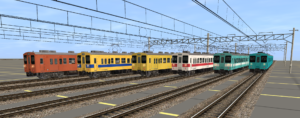
From left to right: JNR “Metropolitan” vermillion orange, Fukuen Line livery, Setouchi Area livery, 1st Wakayama Area livery, 2nd Wakayama Area livery and the Kansai Regional Livery.
These are reskins of Keimei’s 119 Series (avaible on the DLS) with upgraded enginespec, enginesounds and hornsound and the 113 Series interior made by hirochi. All the dependencies are included in the package or are avaible on the DLS.
As always, each .cdp includes a ready-to-run 2-car consist.
Note that there are actually three variants of the 105 Series:
– The “Newly Manufactured” or “full-production” cars with three doors – the ones of this pack
– The “Converted Cars with the original front” and four doors, wich were converted from Tozai Line inter-running services 103-1000 and 103-1200 Series (for Kansai Area services) or from 103-0 Series trains (for Senseki Line services only).
– The “Converted Cars with new fronts” – identical to the “Converted ones” but with the front ends of the “newly manufactured cars”.
The 105 Series was introduced by JNR in 1981 to replace the pre-war and immediately post-war EMUs (such as the 40 and 72 Serieses) that were still in use on local lines in western Japan.
These were originally intended to be replaced by 101 Series trains displaced by the introduction of the 201 Series, but it was quickly discovered that this solution was inadequate and could lead to problems: the 101 Series only had KuMoHa cars (Motor Cars with a cab), wich meant that a 2-car set could only be “all-motored” one, an overkill for local lines with few passengers and without the need for high accelleration. Not only, it had also an unnecessarily high energy consumption, wich meant there could have been problems with the substations’ capacity.
As such, JNR had to design an entirely new train specifically for local lines: it was to be cheap and quick to produce, and it also had to have an “1M1T” arrangment: 1 motor car and 1 trailer car per set.
The design of the 105 Series was based mostly on the proven 103 Series, in fact, it shared most of the equipment (traction motors, pantographs, bogeys…) with the former, but some elements were also borrowed from the 201 Series (at the time, JNR’s newest commuter train) such as the roof, interiors and the zinc black area around the front windows.
The 105 Series began passenger services in 1981, simultaneously on three lines: the Fukuen, Ube and Onoda Lines. Ube and Onoda Lines units were formed in 2-car sets and were colored with JNR’s “Metropolitan” vermillion orange, wich was commonly found on DMUs such as the KiHa 40, while the Fukuen Line units were formed in 4-car sets and were fitted in their very own livery of canary yellow with a strong blue line, almost resembling the Shinkansen Doctor Yellow‘s one.
By the mid-1980s, numerous lines in Kansai were being electrified, wich meant that new EMUs were needed. At the same time, JNR had a surplus of 103-1000 Series trains, wich were being replaced by the newer 203 Series on Chiyoda Line subway trough-services in Tokyo.
The solution was natural: JNR converted the 103-1000s to 105 Series specifications by re-forming them 2-car sets, de-motorising one car…
Originally, the converted units also recieved the new front style used on “standard” 105s, but as it was an unnecessary mesaure, it was later decided to keep the older front style to contain costs.
The converted 103-1000s entered service in 1984, with the electrification of the Kisei, Nara and Wakayama Lines, along with a few full-production 105s. All of them were fitted in a cream livery with red lines, soon dubbed “Wakayama Area” livery.
By the time JNR was privatized in april 1987, JR West had inherited 60 full-production 105s and about the same number of converted units. At the same time, the Vermillion orange livery carried by Ube and Onoda Line trains was replaced by a white livery with blue and red lines, the “Hiroshima Livery” (i’m actually still fiddling a lot with the texture files to get an acceptable result, so maybe in the future this livery will be avaible too).
Starting from 2002, the 105 Series underwent JR West’s “N40” refurbishment and “life-extesion” program, with Wakayama area full-production units being recolored as well into a light blue livery with white lines, dubbed the “second Wakayama Area” livery.
In 2009 the various livieries in use on 105 Series trains were changed into two types: Hiroshima and Okayama-area units recieved the all-over yellow “Setouchi” (derived from the Seto Inland Sea on wich the two cities are located), and the units operating in eastern Kansai (Wakayama, Nara and so on) recieved an all-over blue livery, dubbed the “Kansai Regional Livery”.
The 2nd Wakayama Livery was completely replaced by the Kansai Regional Livery in 2015, and the Fukuen Line livery was fully replaced by the Setouchi one in 2017.
At present, JR West is carrying out a massive replacement of JNR-designed rolling stock with the new 227-1000 Series; thus the “converted” 105s are becoming an “endangered species”.
Full-production 105s instead enjoy relative quietness, as they’re far “younger” and less worn-out than converted 105s; as such, there isn’t any plan to replace them yet.
Trivia:
As a side note, JR East also had briefly two 105 Series sets, wich were converted from 103-0s and were used exclusively on Senseki Line services. They were delivered on March 31st, 1987 (the last day of JNR!) and they entered service on April 5th.
As they proved themselves inadequate for the line’s tortuous nature, they were replaced in 1998 by upgraded and refurbished 103 Series trains.
The two were then converted into two non-revenue “training sets” (special trains used for training new railwaymens); with the arrival of newer training sets basend on the 209 Series, they were retired in 2008 and scrapped in the same year.
